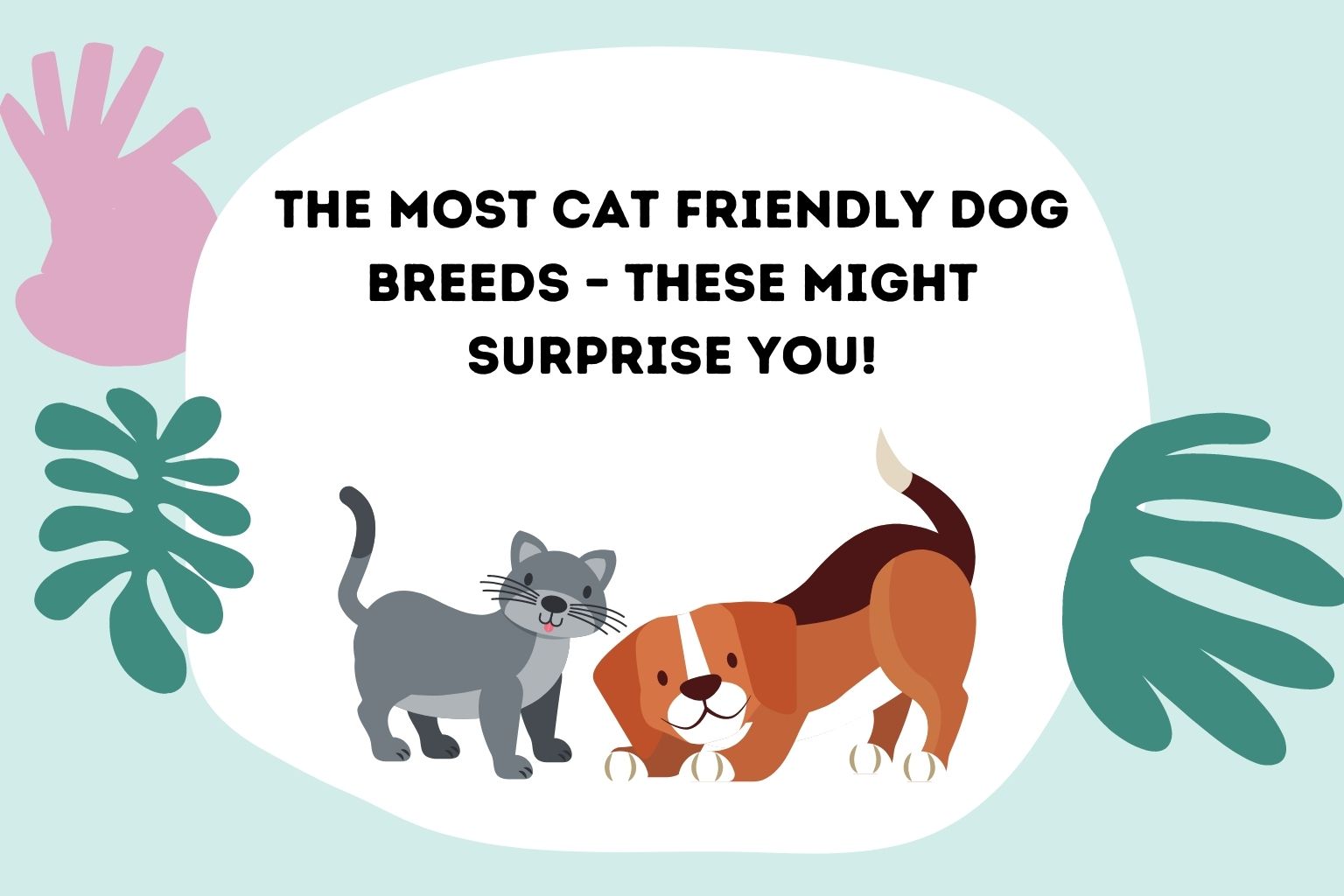Okay, let’s get this out of the way right off – I’m not much of a cat person. I have pointed out, in How to Keep a Dog When You’re on a Tight Budget, that I have had cats, and some of them I’ve been quite fond of. But I’m not really a cat person. Dogs have my heart, plain and simple.
What that means is that I’ve never had to worry about integrating cats into my household – simply because I’ve never especially wanted to.
If I had wanted to have cats and dogs in the same home, though, there would be some breeds that I would consider, and others that I would not.
Some dogs, quite simply, see cats as prey, and no good comes from having them live together. On the other hand, some cats will run roughshod over dogs. So, which dogs do well with cats, and which are best left to just be dogs? Is it really possible for cats and dogs to live compatibly in the same household?
I think it is, but then I’ve been wrong before. Usually when it was someone else’s fault.
Let’s take a look.
Most Cat Friendly Dog Breeds
Here are some of the most cat friendly dog breeds
1. Pomeranian
Many small breeds, like the Chihuahua for example, don’t have very clearly defined breeding histories. Their stories include a hodgepodge of folk lore and educated guesses. But the Pomeranian’s history is a little bit more documented. For example, we know that these dogs come from an area in Northern Europe called Pomerania, on the coast of the Baltic Sea. Most canine historians agree that today’s Pomeranian originated from larger breeds of the Spitz dog breed family. In fact, the earliest Pomeranians were about 30 pounds or so – quite different from the tiny dogs we know today, which average about seven pounds.
The first thing that most people will notice about a Pomeranian is all that hair! These dogs define “fluffy”, with a very dense undercoat supporting a long and thick outer coat. When trimmed in the traditional style of this breed, your Pomeranian may look like a stuffed toy. But beyond the coat, there are other characteristics that these dogs are known for. Being very compact is one of those. Pomeranians average about seven pounds when fully grown, and they have short, stumpy legs that keep them low to the ground. Adults don’t tend to get any bigger than 12 inches, though the average is closer to eight inches.
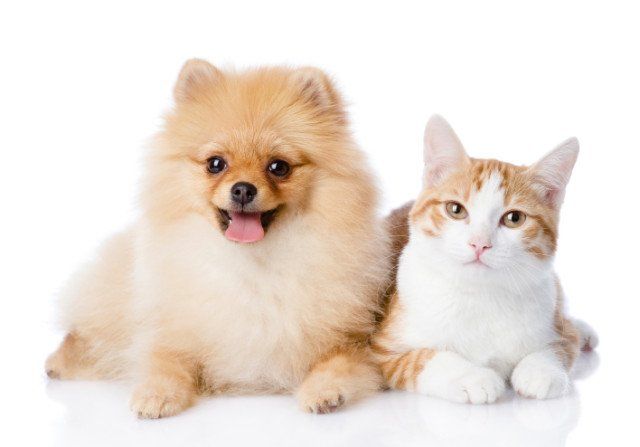
Despite those potentially negative traits, overall the Pomeranian personality is outgoing, curious, and fun. They don’t tend to be very fearful or timid; in fact, don’t be surprised if your Pomeranian becomes the new boss of your pack should you have other pets. They are loving and affectionate with their family, and while busy, they aren’t so active that they bounce off the walls. This makes them ideal pets for someone who wants a good mix of fun without the destruction.
You might not think that these little dogs so known for being ankle-biters would be among the most cat friendly dog breeds, but they are. They’re actually very cat friendly, maybe because they’re just about the size of a cat. Usually, they’ll share your lap with your cat, and get along very well.
2. Chihuahua
Here we’re talking about a very confident little dog that typically won’t weigh much more than seven pounds – in other words, he’s pretty much also the size of a cat.
The little Chi is a very graceful dog that seldom tops more than 6 pounds. He has full, erect ears and very expressive eyes. His coat can be either short or long, and can have many colors.
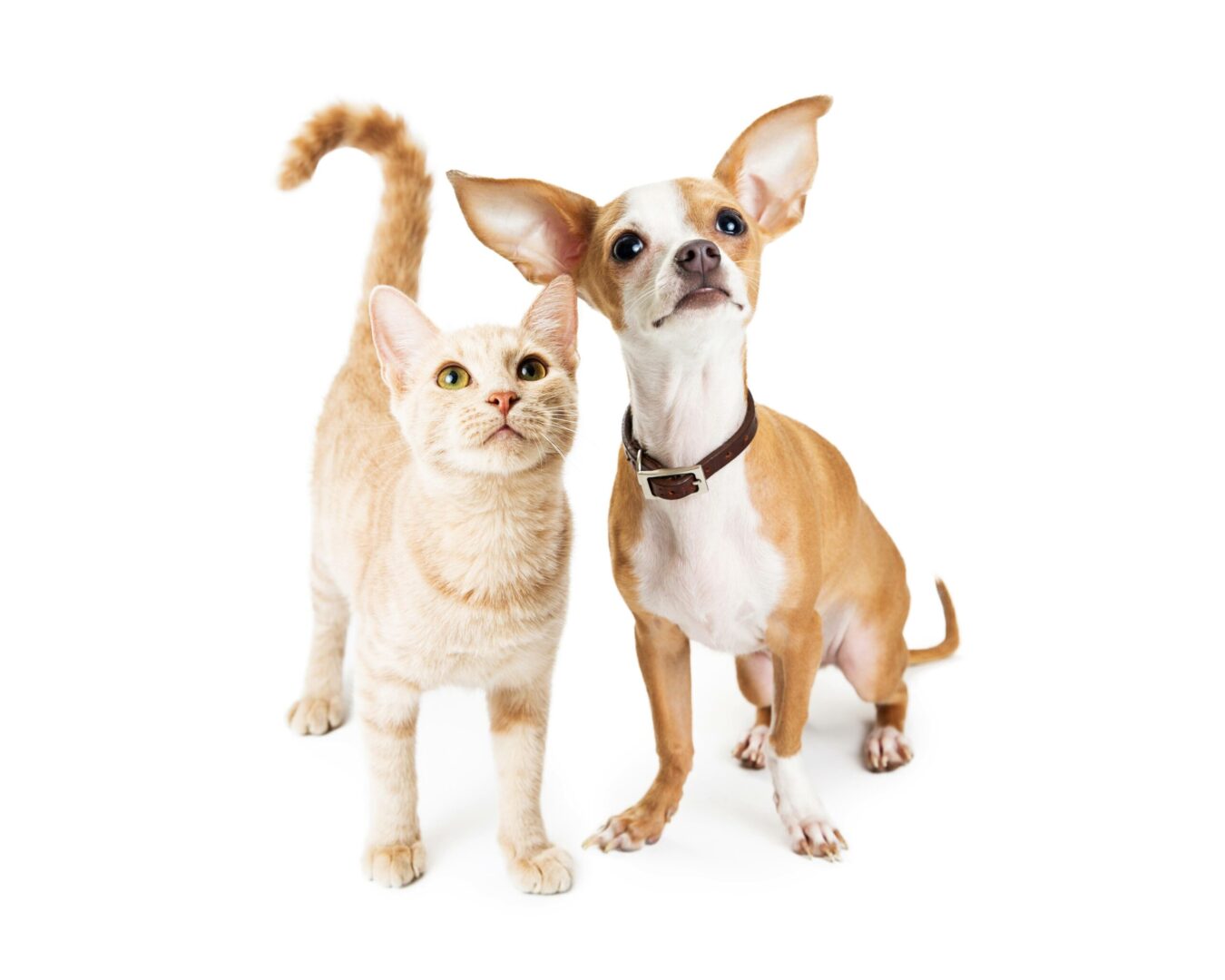
These little guys don’t know that they’re little – they can have the same attitude as a big dog. And although they’re a bit too small to be playing with other dogs, or with children, they’re great with cats! In fact, Chihuahuas are very adaptable—as long as they get a ton of attention, they’ll probably be just fine with cats or any other small animals that you have in your household.
Related Content:
16 Best Small Guard Dogs for Apartments
Top 7 Breeds to Convert the Cat Lover in Your Life
11 Safest Dog Breeds
3. Cavalier King Charles Spaniel
This dog is the definition of laid back. They make great therapy dogs and are very tolerant of other animals. Be sure to provide lots of lap space, though, because this dog is a cuddler.
To no one’s surprise, the Cavalier King Charles Spaniel was originally bred in England, and it’s a shockingly young breed. The breed that we know today is considered to have been developed in the 19th century, sometime around 1882 – that’s not long at all in the grand scheme of things. The reason for this breed’s development? Bird hunting. The breed was developed to flush out birds and make them fly into the air so that hunters could shoot them – making them the perfect companion for wealthy Victorian men of the era. It’s an interesting change from the norm that we often see with smaller dogs, who were often bred as companions for ladies. The Cavalier King Charles Spaniel is definitely man’s best friend, with his mind solely occupied on when the next hunt can be.

It’s in the personality department that a Cavalier King Charles Spaniel really shines, and this is why I think it’s a shame that this breed isn’t more popular. They don’t need a ton of exercise or training to be calm and kind hearted. They love being with their human, and are extremely friendly with strangers. They can tolerate hot weather just fine, and they love playing with other dogs as well.
4. Sheltie
The Sheltie, or Shetland sheepdog, comes from the Shetland Islands between Norway and Scotland. Although it is not known for certain, it is believed that the Sheltie’s original purpose was to protect small Shetland sheep from predatory birds. This could be true, because one of the traits of the breed is a huge interest in birds. Shelties love to chase birds, and some will even take off in hot pursuit of helicopters and airplanes.
Somewhere around the turn of the 19th century, Shelties were brought to Scotland and England, and were referred to as “miniature collies.” Farmers on the Shetland Islands were also breeding smaller, fluffier Shelties to sell as pets. Other small dogs are also believed to have been bred with Shelties, and by the end of the century, Shetland Islanders became concerned that the original Sheltie was in danger of disappearing. Some breeders began breeding their animals with Collies to get back to the original appearance, while others believed that only Shelties should be bred with Shelties, and only those of the types that most closely favored the original type. Still, others continued to breed with a variety of small dogs.
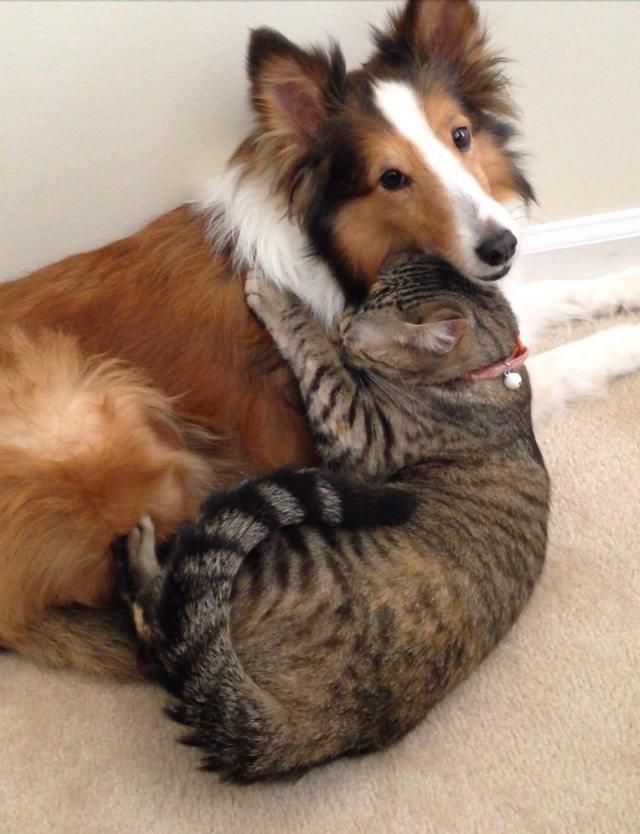
With so much disagreement among breeders, different Sheltie clubs were formed, supporting the different ideas of what a Sheltie should look like. In 1930, the clubs all finally got together, and agreed that the Sheltie should look like a miniature collie.
Shelties can vary quite a bit in terms of personality, being either very outgoing or quite shy, with a full range in between the two extremes. They may be wary of strangers, so if you’re shopping for a Sheltie puppy, you should not be put off if he doesn’t come up to you right away. However, if you get down on the floor with him, he should be curious enough to come over to you and try to make friends. Three traits that virtually all Shelties have in common are a gentle nature, loyalty, and sensitivity. Shelties are very devoted to their people, and reluctant to let them out of their sight.
This working breed likes to herd, and he’ll be just as happy herding cats as he will other animals. He’s one of the most cat friendly breeds because he genuinely has no issues with other animals.
5. Beagle
The Beagle is a small, compact dog that has an incredible sense of smell. Because of his amazing nose-power, the Beagle is highly prized for his ability to track small game. In addition to his hunting ability, the Beagle is a fun-loving dog that is well-suited to families, and also gets along well with other animals.
It’s not really known where the name “Beagle” originated. It’s believed, though, that it could have come from “begueule,” a French word meaning “open throat” – no doubt a reference to the Beagle’s distinctive baying voice. The origin of the breed is also a bit in the dark, because the Beagle as we know him really didn’t come into focus until the 19th century. There are documents from ancient Greece (around 400 BC), though, that refer to dogs that resemble Beagles. In British History, Henry VII is believed to have owned Beagle-like dogs, and his granddaughter, Elizabeth I, is also said to have kept small Beagle-like dogs, standing about eight inches high, that she carried around with her tucked into her sleeves.
Beagle-like dogs are also believed to have been used briefly in the 1500s for fox hunting, but they soon fell out of favor because their stubby little legs kept them from moving quickly enough to outrun the foxes. These dogs, though, are believed to be the forerunners of today’s Beagle.
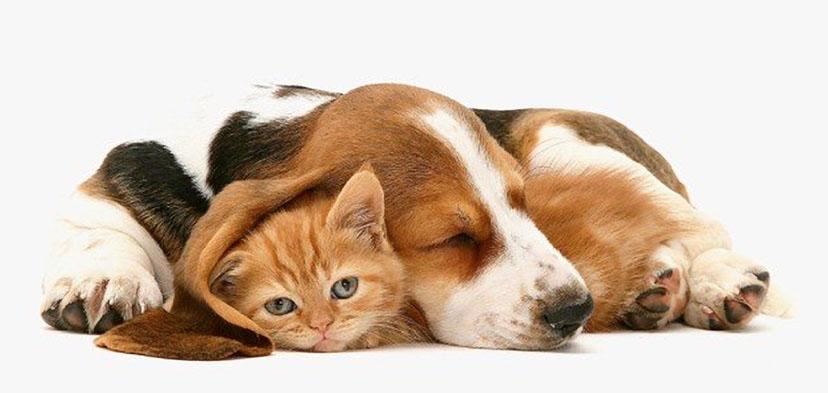
Beagles are typically gentle, and very smart. They often want to be the boss in the relationship, though, so they can be a bit hard to train. Even if you use treats to train your Beagle, it might only result in temporary obedience until he thinks he can get something over on you. A fully-trained Beagle is a pleasure to own, but you’ll need a good deal of patience to get him to the point of being completely trained.
The Beagle also rates among the most cat friendly dog breeds, mainly because this is a dog with a very sweet disposition. Although the Beagle was bred for hunting, his gentle nature makes him very good with cats and other small animals.
6. Golden Retriever
The Golden Retriever is one of the most popular breeds, given that it is extremely intelligent and tolerant. This makes the Golden an outstanding family pet, and a great working dog as well. The retriever is agile, intelligent, loyal and very friendly. Naysayers will tell you that the Golden matures slowly, and tends to hang onto puppyhood a lot longer than other breeds, but people who love Goldens will tell you that they’re more than willing to wait for them to grow up and act their age!
Originally, Goldens were bred to retrieve; they love water and have no trouble wading in to fetch a bird felled by a hunter. They thrive on exercise, both mental and physical, so if you’re not using your Golden for hunting, you should be prepared to wear him out in other ways. Many Golden owners will tell you, “If he’s worn out, he’s happy.”
Golden Retrievers are also very much family dogs, so in addition to exercising him, you’ll have to make sure that he has plenty of time with his “pack.” In other words, he’s going to want to be with you 24/7, and is probably going to want to be underfoot.
If you’re considering a Golden, you’re also going to have to understand that he’s not going to be much of a watch dog. Because of his very friendly nature, the Golden will probably allow anyone into your house. There are no burglars, just friends he hasn’t met yet!
The other thing you need to know about the Golden Retriever is that he is a profuse shedder, particularly in the spring and fall. You’ll have to brush him every day, but even that won’t alleviate the problem of having to sweep up after him constantly. Most Golden Retriever owners will tell you that every day, they’ll sweep up enough hair to build another dog.

Goldens are also very active, and will need about an hour of very vigorous exercise every day. So if you’re kind of a “lay back and let the dog do his thing” person, a Golden is not the right dog for you.
If you have kids, a Golden can be a great dog. They’re gentle and kind, and also very good with other animals, but they can be boisterous, so be sure to supervise them around small children and cats.
Goldens are typically calm and sweet-natured, and eager to please. As is the case with all dogs, though, early socialization is important.Okay, so now you know which breeds are the most cat friendly. There are other breeds, though, that you might want to avoid if you have cats in your household.
The other thing is, you can’t count on training to correct the problem. You’re often trying to overcome something that is, quite simply, hard-wired into the dog. You might go on for months, or even years without ever having a problem with a breed of dog that is not typically good with cats, only to have things go wrong in a huge way at some point. So, if you really want to have dogs and cats in the same household, it’s probably best to stick with breeds that are known to be good with cats.
What Other Breeds?
One thing is for sure, the issue of most cat friendly dog breeds generates a lot of debate. I know that just among my own circle of friends, there are those that will denounce certain breeds as being cat-hostile, while others vigorously defend those same breeds.
What I’ve observed on my own, and what I’ve been told by other dog owners, is that there are some breeds that really aren’t all that cat friendly.
I’m sure that all the Pit Bull owners out there are going to tell me that I’m a) nuts, b) a horrible person, c) deluded or d) all of the above, but the reality is that I wouldn’t really recommend that you keep a Pit Bull and a cat in the same household. Pit Bulls have a very strong prey drive, and when confronted with something smaller and faster (like a cat), the prey drive kicks in. If you’re hell bent on keeping a Pitty and a cat in the same household, I would recommend introducing a Pit Bull puppy to an adult cat – not the other way around. A Pit Bull puppy is likely to see an adult cat as the boss. An adult Pitty is more likely to see a cat as prey. It’s not right or wrong – it’s just what it is.
I’d also suggest that bringing an adult Rottweiler or Doberman into a household where there are cats would be a bad idea. Again, it’s the prey drive thing.
Now, I have to tell you that not everybody agrees with me. If you take a look at TheCatSite.com, you’ll probably find the level of disagreement astonishing. Tons of people post comments like, “What are you talking about; I’ve had cats and dogs together for years and never a problem!”
In fact, sparkymema claims to have had three dogs and three cats living together compatibly for years.
juriesempai says that she’s had a Chihuahua and a Jack Russell mix living compatibly with cats for practically forever.
omqhqmike has seven cats that have been living with two Dobermans quite happily for quite some time.
On the other hand, there are those who believe that cats and dogs are not generally a good mix, and in fact must be supervised constantly. kittenboy says that his Sheltie ended up killing his cat.Since that happened, kittenboy hasn’t given up on keeping cats, but has identified distinct living areas for the dogs and cats, and keeps them separated.
Related Content:
16 Best Small Guard Dogs for Apartments
Top 7 Breeds to Convert the Cat Lover in Your Life
11 Safest Dog Breeds
The Final Word
So, are cats and dogs good together?It seems that there is a lot of potential for disagreement as to what constitutes the most cat friendly dog breeds.
What I will tell you right now is that I don’t keep cats along with my dogs, despite the fact that I would hardly call a Boxer ill-natured. I don’t think that either Janice or Leroy would deliberately hurt a cat, but they are big dogs, and prone to aggressive play. For that reason, I think it’s best to keep them away from cats.
It seems to me, too, that if we’re talking about the most cat friendly dog breeds, we should be thinking about breeds that are generally kind and gentle, that we know to be good-natured, and that don’t come up over and over on “most aggressive dog breed” lists. Generally, I think that if a dog can be trusted with other dogs, and with children, it’s probably a pretty safe breed to have around cats.
I’d also suggest that if you’re planning on having dogs and cats in the same household, it’s probably best attempted when the dog is young. A puppy that’s raised with cats is more likely to be respectful than an adult dog that’s never been around them.
I don’t much miss the presence of cats in my life, but I do know that there are a lot of people who love cats as much (or at least almost as much) as they love dogs. So if you can’t imagine not having both species in your home, rest assured, harmony can be achieved. It’s easier with certain breeds than others, though, and you’re more likely to have an easy time of it if your dog of choice is among the most cat friendly dog breeds. So take a look above, and make your decision accordingly.
Personally, I believe that there is usually room in a household for both cats and dogs. You just have to take it easy and socialize them properly. So if you love both cats and dogs, tread carefully and do your best to make it work out. I think it can happen!

